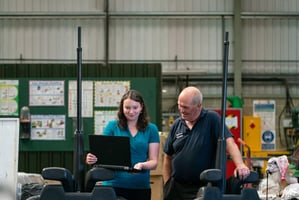Early on in the COVID-19 pandemic, we learned a painful lesson about outsourcing. The fact that...
Robotics: The Next Enhancement to STEM Education
Traditionally, school curricula focused on the ability to read, write, and communicate. As science and technology have advanced, “literacy” has taken on a much broader definition. The contemporary belief is that students must be proficient and fluent in technology tools, be able to manage, synthesize, analyze and critique multiple information streams of simultaneous information, all while maintaining ethical standards. These tasks are even more daunting in a world where globalization has encouraged (or even required in many roles) cross-cultural relationships for ideation, information-sharing, and problem-solving. Soft skills like collaboration, creativity, and critical thinking have become must-have “new literacy” for job applicants. In fact, an Oxford University study found that as many as 47 percent of jobs in the United States will become wholly automated within the next 20 years. This will lead to a transformation of labor, and will generate new job opportunities.
When thinking about how to enhance school curricula to include and develop proficiency in these areas, the first thing that comes to mind for many of us probably is not robotics. The Boomer generation were exposed to “robots” in early TV shows and science-fiction movies. While these were operated by humans in costumes mostly, the notion certainly intrigues many scientists and engineers. Today, the science and technology behind these incredible machines is fueling more and more innovation in the application of robotics. For example, the COVID pandemic, along with the shortage of healthcare workers, the increasing demand for home care alternatives, and the susceptibility to accidents, injuries and contagion, have led medical experts and scientists to develop integrated robotic technology to perform mundane tasks more effectively and more efficiently than humans. With the capability to adapt to particular environments, situations, and tasks, and with the incorporation of artificial intelligence (the science of developing a system or software to emulate human cognition by enabling computers to learn and adapt through experience and patterns, rather than inference), robots are even capable of making decisions. The medical robotics industry will be a $6.5 billion industry in 2020, showing great promise for surgeries that require high levels of precision, including nanosurgery. Robotic surgery is less invasive and allows for a quicker patient recovery time.
The introduction of STEM (science, technology, engineering, and math) programs in schools is a good step toward teaching students the “new literacy.” The addition of robotics in education will take the STEM experience beyond building mechanical devices and coding to learning how to design and create digital technology. According to the findings in a University of Florida study, the incorporation of robotics into curricula improved student attitudes about mathematics and, students working directly with robots demonstrated a higher proficiency in math, science, engineering and technology. Some schools are even offering elementary students the opportunity to work with robots.
Robohub, a non-profit online communication platform that connects experts in robotics research to people in education and business across the globe is committed to expanding robotics education, noting that Just as software engineering led us into the digital age, today, robotic education will be a bridge to the future of innovation. And if the last 10 or so years has been a barometer for the future, companies must innovate continually to survive. There isn’t a better time for this transition. The adage, “Necessity is the mother of invention,” and the COVID pandemic has brought to light many things we need to do differently in the event of another such crisis. We should continue the momentum to innovate more healthcare robotics applications. By exposing children to robotics education early on, they will develop the “new literacy” the jobs will require, and be better positioned to discover and address the future needs for robotic technology.



